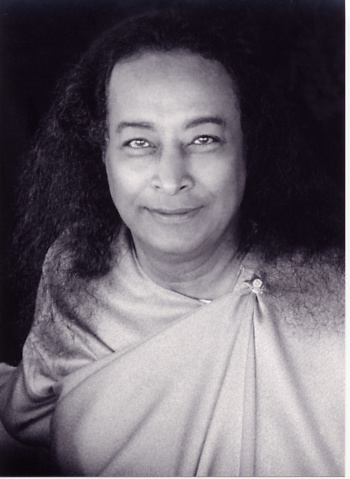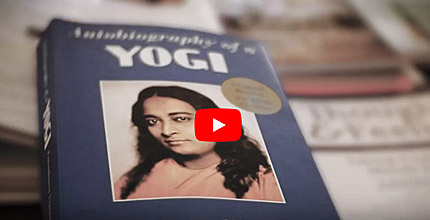
Who is Paramhansa Yogananda? Known also as Swami Yogananda, this was the first yoga master of India to take up permanent residence in the West.
Born Mukunda Lal Ghosh in Gorakhpur, India, in January 1893, Yogananda intensely longed for God from his earliest childhood. As he relates in Autobiography of a Yogi, much of his youth was spent seeking out many different saints.
He met his guru, Swami Sri Yukteswar, in Varanasi around the year 1912 and frequented Yukteswar’s hermitage in Serampore, Bengal while earning an A.B. degree from Calcutta University at Serampore College. To read more about our lineage of spiritual masters, see the Ananda Line of Gurus.
Shortly after graduation in July 1914, Sri Yukteswar initiated Mukunda into the ancient Swami order, at which time the young man assumed the monastic name Swami Yogananda (or, more properly, Yogananda of the Giri branch of the Swami order).
Before embarking on his mission to the West, Yogananda received this admonition from his teacher, Swami Sri Yukteswar:
The West is high in material attainments, but lacking in spiritual understanding. It is God’s will that you play a role in teaching mankind the value of balancing the material with an inner, spiritual life.
To America
It was as Swami Yogananda that he arrived in America in 1920 and proceeded to travel throughout the United States on his “spiritual campaigns” for the next four years. During this time, hundreds of thousands filled the largest halls in major American cities to hear the yoga master from India. Yogananda transcended cultural, social, and religious boundaries.
In 1925, Swami Yogananda acquired and settled in Mount Washington in Los Angeles, California as the headquarters of what would become a worldwide work. It was here he gathered disciples and trained many of them as teachers and ministers, including Ananda’s founder, Swami Kriyananda. In 1927, he received an unprecedented invitation to the White House, where he was received by President Calvin Coolidge.
From 1935 to 1936 Yogananda made a return visit to India. During this time Sri Yukteswar bestowed on him the higher monastic title of Paramhansa, literally “supreme swan” (representing qualities of making discriminating choices for the highest). Thus, Swami Yogananda became Paramhansa Yogananda, the name by which he is known today. (The title Paramhansa supersedes Swami, thus he is properly referred to as Paramhansa Yogananda rather than Swami Paramhansa Yogananda.) Mahatma Gandhi asked Yogananda to initiate him into Kriya Yoga, the highest technique on Yogananda’s path of Self-realization.
After returning to America in 1936, Yogananda continued to lecture and write until his passing in 1952. Although his impact on Western culture was truly impressive during his lifetime, his lasting spiritual legacy has been even greater. His Autobiography of a Yogi, first published in 1946, helped launch a spiritual revolution in the West. Translated into more than fifty languages, it remains a best-selling spiritual classic to this day.
The Path of Self-Realization
The true basis of religion is not belief, but intuitive experience. Intuition is the soul’s power of knowing God. To know what religion is really all about, one must know God. -Paramhansa Yogananda, The Essence of Self-Realization
The lasting contribution brought by Yogananda to the West is the non-sectarian, universal spiritual path of Self-realization. He emphasized the direct inner experience of God. His teachings are nonsectarian and offer a practical approach to spiritual awakening.
Yogananda gave this definition to the term Self-realization:
Self-realization is the knowing in all parts of body, mind, and soul that you are now in possession of the kingdom of God; that you do not have to pray that it come to you; that God’s omnipresence is your omnipresence; and that all that you need to do is improve your knowing.
As the means of attaining this exalted spiritual state Yogananda initiated his followers into the ancient technique of Kriya Yoga, which he called the “jet-airplane route to God.” The path of Kriya Yoga combines the practice of advanced yogic techniques with spirituality in daily life and can be learned through the Ananda Kriya Sangha.
Autobiography of a Yogi
Autobiography of a Yogi is a first-hand account of the life experiences of Paramhansa Yogananda. It is known as one of the best-selling spiritual classics of all time, read by millions of people all over the world, and recognized universally by varying religious traditions as a beautiful depiction of the spiritual path.
It is a treasured collection of stories, humor, and practical and scientific explanations of the great yoga wisdom of the East, and it was voted one of the 100 best spiritual books of the 20th century. Start reading now online for free.
Quote from Yogananda
I Baptize Myself in the Waters of My Tears of Love
Through long, winding pathways of self-doubt, fording mighty rivers that separated Thee from me, trudging over endless wastes of barren lives, tossing dangerously on the rapids of many ambitions, arduously climbing steep mountain trails of desire, and carefully extricating myself from whirlpools of alternating sadness and hilarity – at last I have reached my journey’s end. I look upon all those past travails with joy. Every struggle, every past agony, has produced a flowing spring of joyous, grateful tears. In the sacred waters of those tears, I baptize myself daily with deep love for Thee. -from Whispers from Eternity
Start a New Meditation Practice or Inspire Your Current One
The 10-week Ananda Course in Meditation online course is designed to provide in-depth instruction in scientific meditation techniques that bring more peace, deeper relaxation, and focused concentration to every area of your life, regardless of outer conditions.
These techniques are based on the teachings of Paramhansa Yogananda, author of Autobiography of a Yogi.

